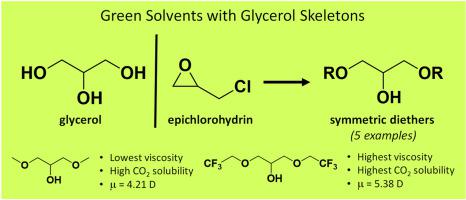当前位置:
X-MOL 学术
›
Fluid Phase Equilibr.
›
论文详情
Our official English website, www.x-mol.net, welcomes your
feedback! (Note: you will need to create a separate account there.)
Properties of symmetric 1,3-diethers based on glycerol skeletons for CO2 absorption
Fluid Phase Equilibria ( IF 2.8 ) Pub Date : 2020-10-01 , DOI: 10.1016/j.fluid.2020.112718 Shuai Qian , Xiaoyang Liu , Grayson P. Dennis , C. Heath Turner , Jason E. Bara
Fluid Phase Equilibria ( IF 2.8 ) Pub Date : 2020-10-01 , DOI: 10.1016/j.fluid.2020.112718 Shuai Qian , Xiaoyang Liu , Grayson P. Dennis , C. Heath Turner , Jason E. Bara

|
Abstract CO2 absorption is at the forefront of separation processes due to the attention given to greenhouse gas emission control and its potential to slow global climate change. This report describes the study of new physical solvents for CO2 absorption through a single step etherification of epichlorohydrin, yielding symmetric 1,3-diethers based on a glycerol skeleton. Five such compounds were obtained in this manner: 1,3-dimethoxypropan-2-ol (DMP, 623-69-8), 1,3-diethoxypropan-2-ol (DEP, 4043-59-8), 1,3-di(propan-2-yloxy)propan-2-ol (DIPP, 13021-54-0), 1,3-bis(2-methoxyethoxy)propan-2-ol (DMEP, 130670-52-9), and 1,3-bis(2,2,2-trifluoroethoxy)propan-2-ol (DTEP, 691-26-9). Screening of synthesis methods was conducted and aqueous sodium hydroxide solution was found to be the best reaction medium. All compounds were purified through rigorous distillation and drying techniques. Density and viscosity values for each compound were collected in the range of 293.15–353.15 K. CO2 absorption capacities of these solvents were measured at 303.15, 318.15, 333.15 and 348.15 K at CO2 partial pressures in the range of 2–6 atm. Miscibility of these compounds with common organic solvents and water was also determined. Dipole moments were calculated for exploration of structure – property relationship. Among these solvents, DMEP and DTEP exhibited the largest affinity for CO2 with Henry's constants of 48.0 and 45.4 atm, respectively, at 303.15 K, reaching the same level as diglyme used industrially while allowing further modification for improvement in CO2 capture ability. Data obtained in this work should be useful as a guide for further design and synthesis of solvents based on glycerol skeletons for CO2 absorption applications.
中文翻译:

基于甘油骨架的对称 1,3-二醚吸收 CO2 的性质
摘要 由于对温室气体排放控制的关注及其减缓全球气候变化的潜力,CO2 吸收处于分离过程的最前沿。本报告描述了通过单步环氧氯丙烷醚化作用吸收 CO2 的新物理溶剂的研究,产生基于甘油骨架的对称 1,3-二醚。以这种方式获得了五种这样的化合物:1,3-二甲氧基丙-2-醇(DMP,623-69-8)、1,3-二乙氧基丙-2-醇(DEP,4043-59-8)、1,3 -二(丙-2-基氧基)丙-2-醇(DIPP, 13021-54-0), 1,3-双(2-甲氧基乙氧基)丙-2-醇(DMEP, 130670-52-9),和1,3-双(2,2,2-三氟乙氧基)丙-2-醇(DTEP,691-26-9)。对合成方法进行了筛选,发现氢氧化钠水溶液是最佳反应介质。所有化合物均通过严格的蒸馏和干燥技术进行纯化。在 293.15-353.15 K 范围内收集每种化合物的密度和粘度值。在 2-6 个大气压范围内的 CO2 分压下,在 303.15、318.15、333.15 和 348.15 K 下测量这些溶剂的 CO2 吸收能力。还测定了这些化合物与常见有机溶剂和水的混溶性。计算偶极矩以探索结构-性质关系。在这些溶剂中,DMEP 和 DTEP 对 CO2 的亲和力最大,在 303.15 K 时的亨利常数分别为 48.0 和 45.4 个大气压,达到与工业上使用的二甘醇二甲醚相同的水平,同时允许进一步改性以提高 CO2 捕获能力。
更新日期:2020-10-01
中文翻译:

基于甘油骨架的对称 1,3-二醚吸收 CO2 的性质
摘要 由于对温室气体排放控制的关注及其减缓全球气候变化的潜力,CO2 吸收处于分离过程的最前沿。本报告描述了通过单步环氧氯丙烷醚化作用吸收 CO2 的新物理溶剂的研究,产生基于甘油骨架的对称 1,3-二醚。以这种方式获得了五种这样的化合物:1,3-二甲氧基丙-2-醇(DMP,623-69-8)、1,3-二乙氧基丙-2-醇(DEP,4043-59-8)、1,3 -二(丙-2-基氧基)丙-2-醇(DIPP, 13021-54-0), 1,3-双(2-甲氧基乙氧基)丙-2-醇(DMEP, 130670-52-9),和1,3-双(2,2,2-三氟乙氧基)丙-2-醇(DTEP,691-26-9)。对合成方法进行了筛选,发现氢氧化钠水溶液是最佳反应介质。所有化合物均通过严格的蒸馏和干燥技术进行纯化。在 293.15-353.15 K 范围内收集每种化合物的密度和粘度值。在 2-6 个大气压范围内的 CO2 分压下,在 303.15、318.15、333.15 和 348.15 K 下测量这些溶剂的 CO2 吸收能力。还测定了这些化合物与常见有机溶剂和水的混溶性。计算偶极矩以探索结构-性质关系。在这些溶剂中,DMEP 和 DTEP 对 CO2 的亲和力最大,在 303.15 K 时的亨利常数分别为 48.0 和 45.4 个大气压,达到与工业上使用的二甘醇二甲醚相同的水平,同时允许进一步改性以提高 CO2 捕获能力。











































 京公网安备 11010802027423号
京公网安备 11010802027423号